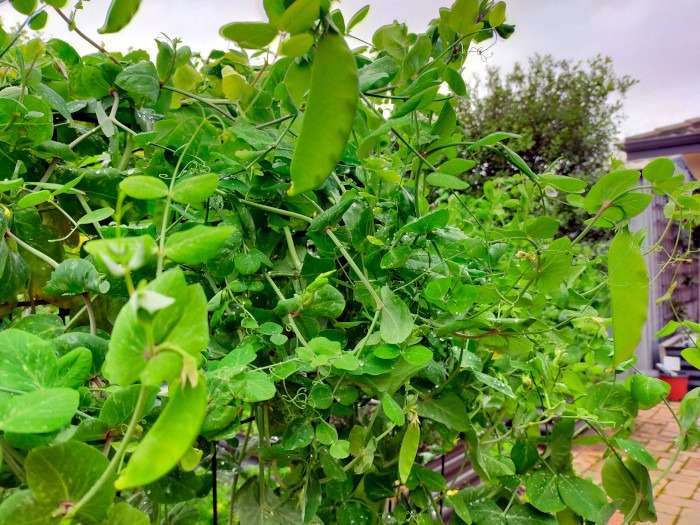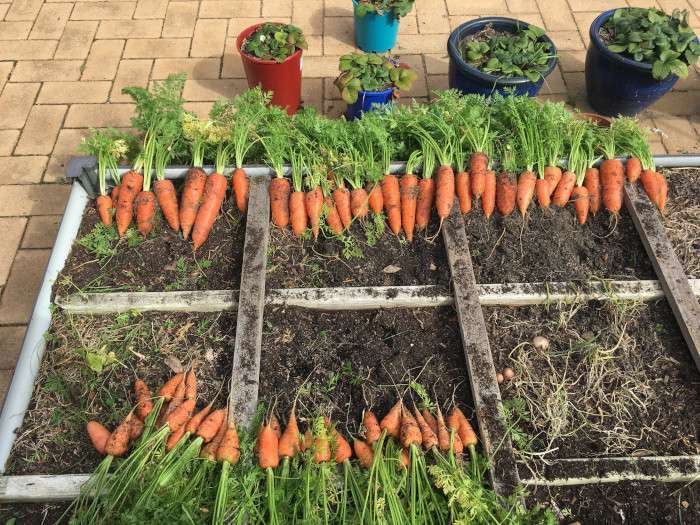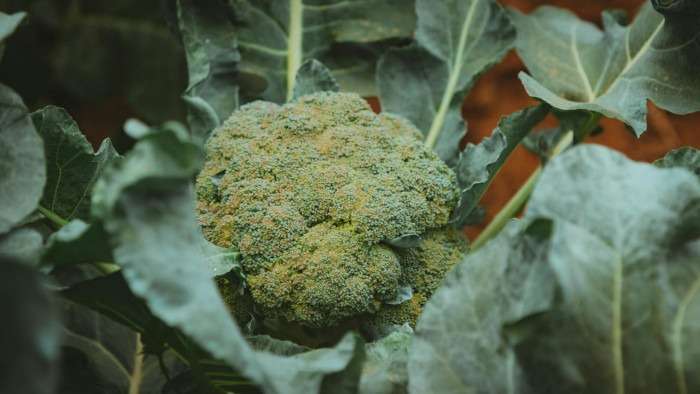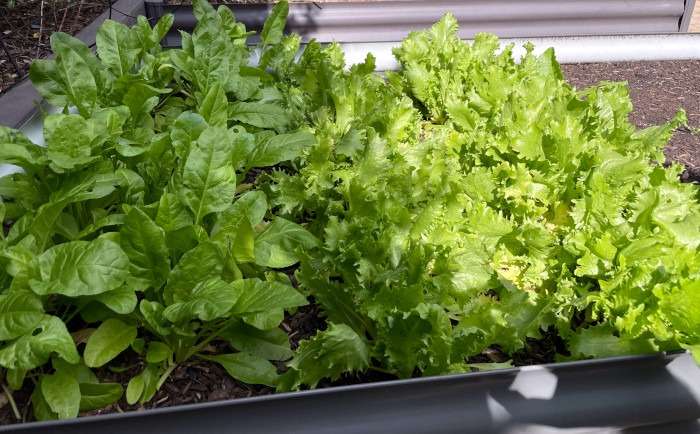It’s that time of year—summer’s heat finally gives way to a welcome cool respite. This shift gives us a chance to grow plants that thrive in cooler temperatures. Whether you’re seeking ideas or simply looking for a refresher on what’s best suited for winter veggie patches in Australia, I’ve got you covered.
Winter happens to be my most successful harvest season, and I’ve made a list of top vegetables that are not only easy to grow but also perfect for a bountiful winter harvest.
1. Snow Peas

My favourite winter veggie to grow and eat, I grow for both the crispy sweet pods as well as the young tender shoots for cooking. It grows really well in my area’s mild winters and always gives me a huge harvest.
Growing Tips
- Spacing: Grow snow peas 10cm apart on a trellis for pods. For shoots, plant tightly and chop tops regularly for continuous harvest.
- Light: For a great harvest, make sure they get at least 6 hours of daylight.
Pests and Diseases
- Powdery Mildew: Water at the base to keep foliage dry and ensure good airflow to prevent fungal issues.
Common Mistakes
- Delayed Harvest: Harvest pods while tender to avoid tough, stringy pods.
- Trellis Size: Use a sturdy trellis that is as tall as the plant to prevent breakage in windy weather.
2. Carrots

Just about every meal I eat uses carrots, making them a staple in my garden. As luck would have it, they’re also very easy to grow and offer a big harvest even in small spaces.
Growing Tips
- Soil: Direct sow in loose, well-drained, slightly sandy soil. Raised beds help prevent compaction.
- Watering: Keep soil moist but not waterlogged, especially during germination.
Pests and Diseases
- Carrot Rust Fly: Use row covers and rotate planting locations. Remove thinned carrots from the surface.
Common Mistakes
- Overcrowding: Thin seedlings to the recommended spacing for healthy roots.
- Inconsistent Watering: Regular watering prevents root splitting.
3. Broccoli

Broccoli is one of those super veggies full of tonnes of nutrients, it also can be used in a variety of dishes. It’s also another of my favourites, often used in our kitchen.
Growing Tips
- Planting: Start broccoli as seedlings and transplant into nutrient-rich soil.
- Harvesting: Harvest when heads are firm, tight, and dark green. Leave some stem for side shoots to develop.
Common Pests and Diseases
- Aphids and Cabbage Worms: Use insect netting for protection.
Common Mistakes
- Delayed Harvest: Harvest promptly to avoid bitter heads.
- Improper Fertilization: Use balanced fertilizer to promote proper head development. Avoid excessive nitrogen.
4. Tomatoes

While traditionally associated with summer, certain tomato varieties do quite well in the cool temperatures of winter. Growing tomatoes out of season is a good way save on costs at the shops and will let you enjoy them year round.
Growing Tips
- Cold-tolerant varieties: Consider growing cold-tolerant varieties in winter or using a polytunnel/greenhouse for cooler climates.
- Start Early: Start seeds in summer and autumn for stronger, mature plants in winter.
- Location: Choose a sunny spot and use a trellis if needed. A hot wall or raised bed can create a warmer microclimate.
Common Pests and Diseases
- Aphids and Whiteflies: Inspect regularly and use horticultural oil as an organic pesticide.
- Early Blight: Disinfect pruners and ensure proper spacing. Mulch to prevent soil splash.
Common Mistakes
- Lack of Pruning: Prune suckers and lower leaves to improve airflow and direct energy to fruiting.
- Overhead Watering: Water at the base to prevent fungal diseases.
5. Spinach

Spinach like most leafy greens thrive in the cool temperatures of winter. We like to grow for the tender baby leaves to be used raw in salads or cooked in stir-fry’s.
Growing Tips
- Planting: For baby leaves, plant closer together. Provide consistent moisture and partial shade to prevent bolting in warm climates. In cloudy areas, give them as much sun as possible.
Common Pests and Diseases
- Slugs: Use slug bait for high numbers; let natural predators handle low numbers.
Common Mistakes
- Overwatering: Excess water can cause rotten foliage. Reduce watering during rainy periods.
- Neglecting Harvest: Harvest spinach regularly to avoid tough, bitter leaves.
Note: I’m often guilty of neglecting the harvest of my crops. I get excited growing them but sometimes forget or struggle to stay on top of the harvesting. Don’t grow too much unless you have a high demand or other hands to help you in the garden.
6. Lettuce

Another classic leafy green, perfect for more shady winter conditions and you can grow it both for the heads or for leaves to go in salads or other dishes. We always grow a lot of lettuce as it’s so flexible in cooking and has a lot of interesting varieties to try.
Growing Tips
- Planting: Use closer spacing and cut-and-come-again method for leaves. Space out for heads. Both direct sowing and seedlings work well. They thrive in shadier spots, especially for leaf production.
Common Pests and Diseases
- Slugs: Use slug bait for high numbers, and let natural predators manage low numbers.
Common Mistakes
- Overwatering: Too much water can cause rotten foliage. Reduce watering during rainy periods.
- Underwatering: Lack of water leads to bitter leaves and poor growth. Keep the soil consistently moist.
- Neglecting Harvest: Harvest leaves regularly to avoid tough, bitter foliage.
7. Kale

Kale grows well in cooler, shadier areas, and is frost hardy making it perfect for winter gardens. I don’t grow too much in my own garden but whenever I do use it, I’m bound to get some nutritious goodness.
Growing Tips
- Spacing: For heads, plant 30cm apart and harvest regularly to encourage further cropping.
- Frost: Exposing kale to frost can improve flavour by converting starches to sugars. Consider leaving some plants in the garden after the first frost for sweeter leaves.
Common Pests and Diseases
- Slugs: Use slug bait for high numbers, and let natural predators manage low numbers.
- Aphids and Cabbage White Butterfly: Inspect regularly, use horticultural oil, and consider insect netting to prevent pests.
Common Mistakes
- Inadequate Thinning: Failure to thin seedlings to the recommended spacing can cause overcrowding, smaller harvests, and increased pest/disease risks.
8. Cabbage

Gardeners appreciate growing cabbage for its resilience, productivity, and versatility in the kitchen. Its ability to thrive in various climates, coupled with its high yield per plant, makes it a good addition to the garden. It also stores pretty well, so you can make your harvest go further.
Growing Tips
- Blanching: About two weeks before harvest, gently pull outer leaves over the head and secure with twine or rubber bands. This shields the inner leaves from sunlight, resulting in sweeter, tender leaves.
- Fermentation: Consider fermenting surplus cabbage to make sauerkraut or kimchi, which preserves the harvest and enhances nutritional value through probiotics.
Common Pests and Diseases
- Slugs: Use slug bait for high numbers and allow natural predators to manage low numbers.
- Cabbage White Butterfly: Use netting to prevent butterflies from laying eggs, reducing caterpillar infestations.
Common Mistakes
- Overwatering: Excessive watering can lead to rotten foliage. Let soil and foliage dry out if you’re getting a lot of rain.
9. Beetroot

One of my favourites to add to burgers! Beets are usually grown for their delicious red roots but the leaves are also edible and can be used in salads or served as a side.
Growing Tips
- Direct Sow: Beets should be directly sown into loose, well-drained soil, similar to carrots. Thin seedlings to allow proper root development.
- Harvest Timing: Harvest beets at any stage; smaller roots are sweeter and tender, while larger roots have a more earthy flavour and firmer texture.
Common Pests and Diseases
- Aphids: Use horticultural oil to reduce aphid populations and prevent damage.
- Powdery Mildew: Spray affected foliage with a mixture of 15 ml baking soda, 5 ml liquid soap, and 4L water for mild cases. Remove severely infected plants to prevent spread.
Common Mistakes
- Inadequate Thinning: Avoid overcrowding by thinning beet seedlings to recommended spacing for healthy root growth.
10. Onions

Onions are highly adaptable in cooking and store really well, making them an ideal option for home gardeners. Although cheaply available at stores, growing onions in large quantities can be nice, especially if you eat a lot of them like we do.
Growing Tips
- Dedicated Growing Area: Onions need a dedicated space due to their long maturation period. Cold weather promotes bulb growth.
- Spacing: Ensure adequate spacing to allow proper bulb development.
- Harvest: Onions are ready when the top foliage turns brown and begins to topple.
Common Pests and Diseases
- Aphids: Aphids may target onion foliage but generally don’t impact bulb growth. Use horticultural oil if necessary to control them.
Common Mistakes
- Overwatering: Avoid waterlogged soil, as it can lead to bulb rot.
- Under Fertilization: Onions require nutrient-rich soil to grow large bulbs. Make sure the soil is fertile for optimal growth.
Conclusion
By carefully selecting crops, understanding their needs, and applying proper care techniques, you can enjoy fresh produce even in cooler months. Whether you’re a seasoned gardener or just starting out, experimenting with different crops over winter can yield surprising results. So, embrace the advantages of cool weather and get gardening!

